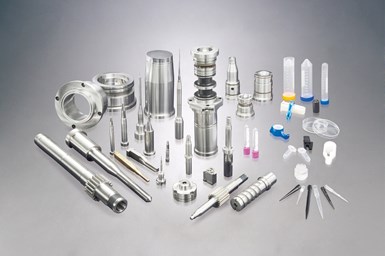Bonding, Sintering Tech Advances Metal Bonding for Mold, Die Components
NPE2024: Punch Industry USA exhibits P-Bas, intended to replace the use of 3D printers when producing mold and die components, as well as a variety of mold component supplies.
Photo Credit, all images: Punch Industry USA
Punch Industry USA Inc. is exhibiting its parent company’s bonding and sintering technology called P-Bas. P-Bas, an alternative to 3D metal printing, is used to fabricate custom conformal cooling channels for mold and die components by bonding split parts, offering an extensive compatibility with iron-based materials. Punch Industry has applied for a patent for this novel technology.
P-Bas, denoting Punch Bonding and Sintering, employs heat and pressure for metal bonding, achieving joint strength surpassing 90% of the base material. Additionally, P-Bas produces parts and cooling lines with a finer, smoother surface finish than that of 3D metal printed parts; the process includes a surface coating to reduce rust formation in the cooling lines.
Parts that can be made using P-Bas include gate inserts for components to make plastic bottles, core pins for injection and die-cast molds, and sprues.

Customers can initiate the P-Bas ordering process by designing components with cooling channels, approving suggested split parts and receiving a quotation. Rigorous testing, encompassing bend tests for joint strength and leak tests for watertight integrity ensures the reliability of P-Bas technology.
Related Content
-
Medical Tubing: Use Simulation to Troubleshoot, Optimize Processing & Dies
Extrusion simulations can be useful in anticipating issues and running “what-if” scenarios to size extruders and design dies for extrusion projects. It should be used at early stages of any project to avoid trial and error and remaking tooling.
-
Updated Software Reduces Die Design Iterations
New software said to reduce the number of fine-tuning iterations and die development time by at least 50%.
-
New Rotary Die and Cam Lock Design for Tubing
NPE2024: New design enables quick and easy assembly and disassembly of the crosshead, and eliminates the socket head cap screws.

